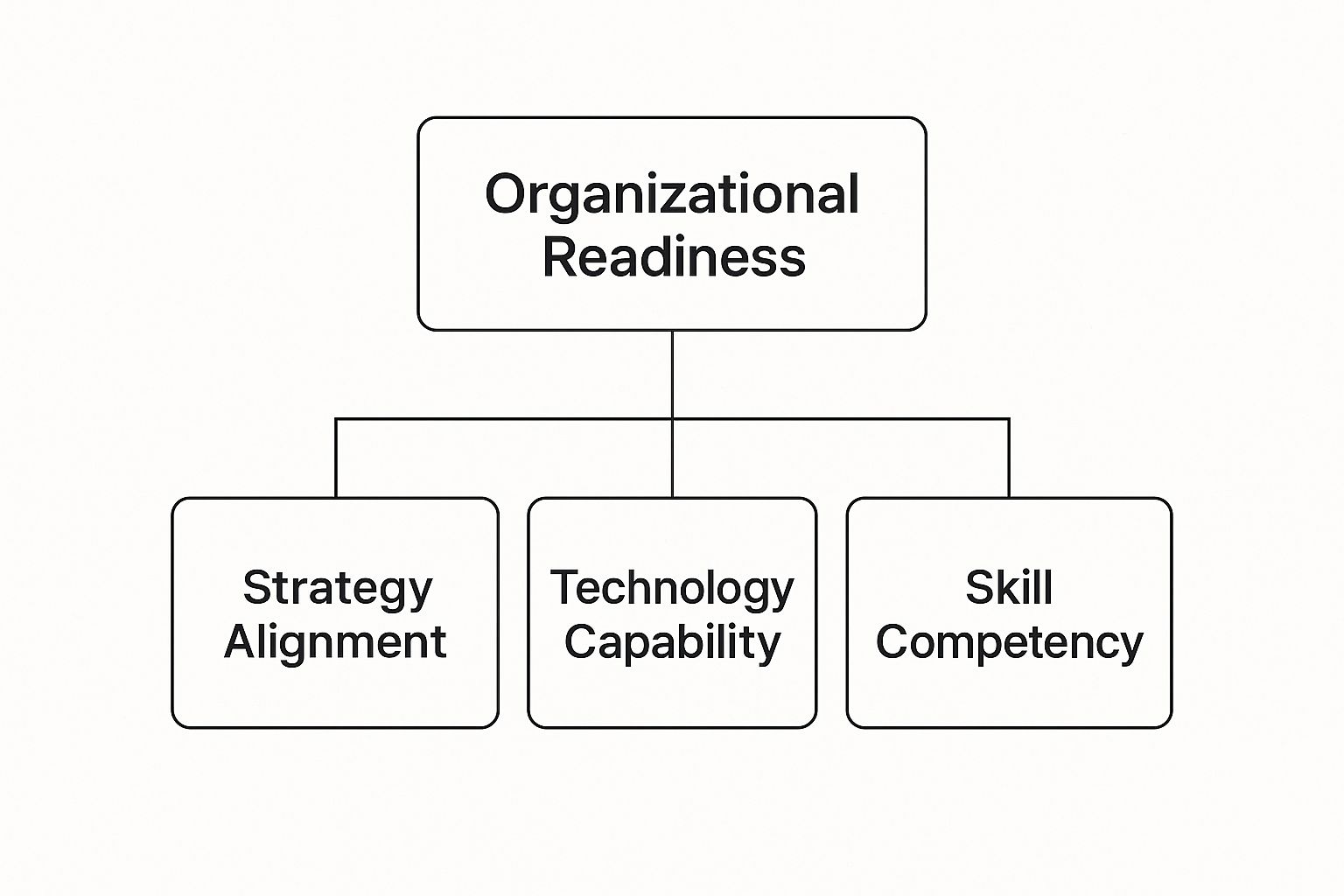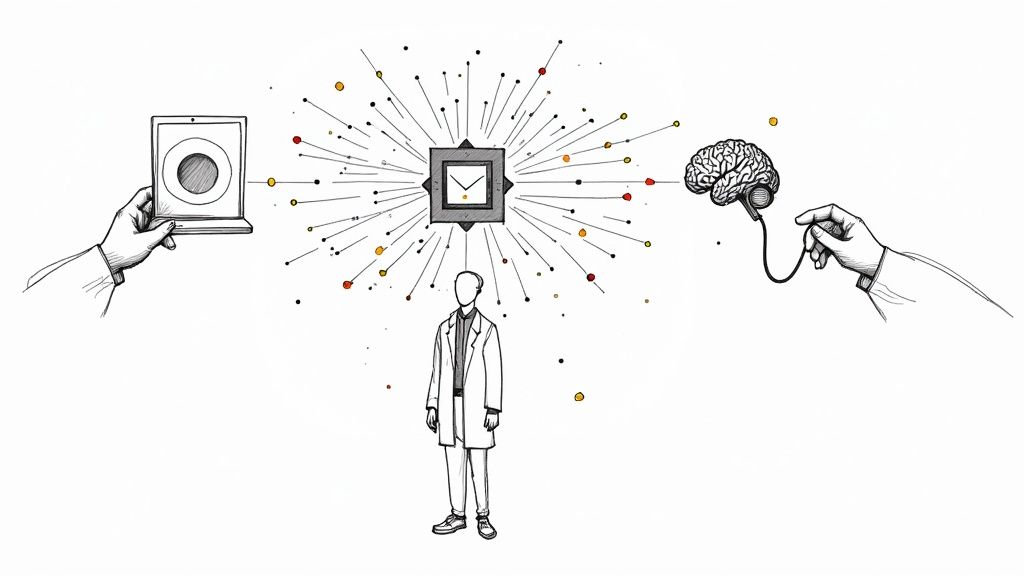Build Your AI Enablement Framework
Unlock your organization's potential with a robust AI enablement framework. Learn the core components, benefits, and steps to drive successful AI integration.

Think of an AI enablement framework as your company's strategic blueprint for artificial intelligence. It's not about a rigid set of rules you have to follow blindly. Instead, it’s a living, breathing system that weaves together the right technology, skills, processes, and even your company culture to create the perfect environment for AI to thrive and deliver real business results.
Why You Need an AI Enablement Framework
Dipping your toes into AI with a few tools here and there, without a solid plan, is a classic recipe for disappointment. It often leads to wasted money, new compliance headaches, and a frustrating lack of return on your investment. I’ve seen many organisations jump into AI with isolated projects, only to find themselves managing chaos rather than innovation.
This ad-hoc approach almost always creates fragmented efforts, where a success in the marketing department can't be replicated in finance because they're on completely different tracks. This is exactly where a structured approach becomes non-negotiable. An AI enablement framework acts as the central nervous system for your AI initiatives, making sure every part of the business is working together. It’s what turns AI from a collection of scattered experiments into a powerful, strategic capability that drives real-world outcomes.
Think of it like this: You wouldn't build a skyscraper without a detailed architectural blueprint, a solid foundation, and a skilled construction crew all working from the same plan. An AI enablement framework is that blueprint for your business, ensuring your AI initiatives are built to last and reach their full potential.
This systematic approach is a core part of effective AI co creation, creating a direct line between AI's potential and measurable business growth.
Solving Common AI Adoption Challenges
Without a framework, organisations stumble into the same predictable and damaging problems time and time again. A well-designed framework gives you the structure to anticipate and solve these issues before they can derail your progress. It provides a single, unified direction and helps you sidestep the common pitfalls of uncoordinated AI implementation.
Some of the most common challenges that pop up without a clear structure include:
- Inconsistent Governance: Different teams might use AI tools without consistent ethical checks or risk assessments, exposing the business to significant compliance and reputational damage.
- Wasted Resources: Multiple departments could be unknowingly building or buying similar AI solutions, leading to redundant spending and duplicated effort.
- Siloed Knowledge: Valuable insights and lessons learned from one AI project get trapped within that team, preventing the wider organisation from benefiting.
- Poor Data Quality: AI models are only as good as the data they eat. Without centralised data standards, teams often use inconsistent or low-quality data, which leads to unreliable and biased AI outputs.
A framework addresses these problems head-on by establishing clear guidelines, shared resources, and centralised oversight from the very beginning.
The Strategic Value of Structure
Adopting a framework isn’t just about dodging bullets; it's about unlocking strategic value. It gives you a clear, repeatable process for identifying, validating, and scaling high-impact AI opportunities. This focus on repeatable success is a fundamental aspect of high-level AI strategy consulting, ensuring every AI project is directly aligned with your most important business objectives.
To see the difference clearly, the table below contrasts the typical pitfalls of a scattered AI approach with the solutions a dedicated framework provides.
Common AI Adoption Challenges Solved by a Framework
Challenge Without a Framework
Solution With a Framework
Scattered & Uncoordinated Projects
Disconnected AI tools and one-off projects create chaos and internal competition.
Centralised AI Roadmap & Portfolio
A unified plan aligns all initiatives with overarching business goals, ensuring every project adds value.
High Compliance & Ethical Risks
Ad-hoc use of AI without oversight exposes the company to serious legal and reputational issues.
Standardised Governance & Risk Protocols
Clear rules and automated checks ensure all AI use is safe, ethical, and fully compliant from the start.
Stagnant Skill Development
AI knowledge remains trapped in small, isolated pockets of the organisation.
Organisation-Wide AI Literacy Programmes
Structured training and continuous learning initiatives build foundational AI competency across the entire company.
Unclear & Inconsistent ROI
It's nearly impossible to measure the true business impact or value of disconnected AI experiments.
Defined Metrics & Value Tracking
A consistent system for tracking KPIs and business outcomes proves AI's concrete value.
Ultimately, an AI enablement framework helps your organisation shift its mindset. You move from being reactive and experimental to being proactive and strategic. It builds the solid foundation you need to not only adopt AI but to thrive with it, ensuring that your investment translates directly into a sustainable competitive advantage.
The Four Pillars of a Successful Framework
A solid AI enablement framework doesn't just happen overnight. It’s carefully built on four interconnected pillars. Think of it like building a state-of-the-art skyscraper. Each pillar is absolutely essential; if one is weak or missing, the entire structure is at risk, no matter how strong the others are.
This holistic approach is at the heart of any worthwhile AI strategy framework. It’s about moving past simple tech checklists to create a system that’s truly woven into the fabric of your organisation. As we explored in our AI adoption guide, organisational readiness is what separates a short-term experiment from long-term success.
This infographic really drives home what organisational readiness looks like, showing how strategy, technology, and skills need to be in lockstep.

As you can see, readiness isn't a single checkbox. It's a delicate balance of having a clear vision, the right technical tools, and the human expertise to make it all work.
Now, let's dig into the four pillars that bring this readiness to life.
1. Technology and Data: The Foundation
Every skyscraper needs a rock-solid foundation, and for an AI framework, that foundation is Technology and Data. This pillar is all about the raw materials and essential tools you need to build anything of value. It means having a modern, scalable infrastructure and, crucially, high-quality, accessible data.
Without this, even the most sophisticated AI models are doomed to fail. A UK government department, for instance, realised that before they could even think about AI tools, they first had to audit their entire tech estate to ensure it could securely manage the necessary data.
This pillar covers a few key areas:
- Scalable Cloud Infrastructure: You need the ability to tap into computing power on demand to train and run complex AI models without a huge upfront investment in hardware.
- Data Governance and Quality: This means setting up clear rules for how data is collected, stored, and maintained. It's the only way to ensure your AI's outputs are accurate and trustworthy.
- Integrated Tooling: It’s about choosing the right AI platforms—from data processing tools to model development environments—and making them work together seamlessly.
2. Process and Governance: The Structural Supports
Once the foundation is poured, you need the structural supports—the steel beams, concrete columns, and building codes. This is your 'Process and Governance' pillar. It gives your entire AI operation its strength, stability, and safety, ensuring everything is built correctly.
This pillar defines how you do things. It sets out the workflows, rules, and oversight that guide AI development and deployment, including ethical guidelines, risk management protocols, and clear lines of accountability. For example, the State of Georgia’s AI strategy requires AI impact assessments before implementation, embedding risk management right into the process from day one.
A strong governance process doesn't get in the way of AI; it acts as an enabler of safe and responsible innovation. It facilitates crucial conversations, connects teams with experts, and fosters a culture of accountability.
This is where you build the guardrails that prevent your AI initiatives from going off the rails. It forces you to tackle the tough questions about privacy, fairness, and transparency from the very beginning.
3. People and Culture: The Construction Crew
A skyscraper is just an empty shell without the skilled architects, engineers, and workers who design, build, and maintain it. The People and Culture pillar is your team—the human element that truly brings your AI vision to life. This goes way beyond just hiring a few data scientists.
It’s about nurturing an organisation-wide culture of curiosity and data literacy. It involves upskilling your existing workforce and carefully managing the change that comes with new, AI-powered ways of working. A great framework includes programmes to build AI skills across all departments, from the C-suite to the front line. This is exactly why our AI co-creation model is so effective; it puts the focus squarely on empowering your people.
Key initiatives here often include:
- AI Literacy Programmes: Training for all employees on the basics of AI—what it can do, and just as importantly, what it can't.
- Change Management: Clear communication and support systems to help teams adapt to new AI-driven processes.
- Cross-Functional Teams: Bringing together people from business, tech, and data departments to tackle problems collaboratively.
4. Strategy and Value: The Penthouse View
Finally, at the very top of your skyscraper, you have the penthouse. This is the Strategy and Value pillar. It provides that high-level, panoramic view, making sure that everything you’ve built serves a clear and valuable purpose. This pillar connects every single AI initiative directly back to core business goals.
It answers the most important question of all: "Why are we even doing this?" It's about defining what success looks like, setting up key performance indicators (KPIs), and creating a clear roadmap for achieving a measurable return on investment. Any effective AI strategy consulting engagement always starts here, by defining value first.
This pillar ensures you aren't just adopting AI for the sake of technology, but are actually solving real problems and creating tangible business value, whether that's boosting efficiency or unlocking entirely new revenue streams.
Navigating the AI Regulatory Landscape
When you're building an AI enablement framework, governance isn't just a box to tick; it's one of the most critical pillars for success. Getting a handle on the regulatory environment is non-negotiable. For any organisation in the Netherlands, the EU AI Act isn't some far-off concept—it’s a present-day reality that dictates how you can develop and use AI. The legislation isn't there to stifle progress. It’s designed to build trust and make sure that technology serves humanity responsibly.

The Netherlands has adopted a structured, phased rollout of the EU AI Act, which began taking effect in August 2024. At its heart, the Act uses a risk-based approach, sorting AI systems into clear categories to strike a balance between innovation and citizen safety. This proactive stance is essential for any business operating here, turning compliance from a potential headache into a clear roadmap for responsible growth. You can learn more about the Dutch approach to the EU AI Act on practiceguides.chambers.com.
Embedding these considerations early is a core principle of our AI strategy consulting services. We focus on getting this right from the start to prevent expensive rework later and to build systems that are truly resilient.
Understanding the EU AI Act's Risk Tiers
The EU AI Act classifies AI systems into four distinct risk categories. Think of it as a triage system; it helps organisations focus their governance efforts where they're needed most—on the applications that pose the greatest potential harm.
- Unacceptable Risk: These are AI practices seen as a direct threat to people's safety, rights, and livelihoods. As a result, they are completely banned. This includes things like government-run social scoring or AI designed to manipulate human behaviour in harmful ways.
- High Risk: This category covers AI systems that could seriously impact people's safety or fundamental rights. These are allowed, but only if they meet strict requirements before they ever reach the market.
- Specific Transparency Risk: Here, the main goal is ensuring people know when they are interacting with an AI. Think of chatbots or AI-generated "deepfakes," which must be clearly labelled as such.
- Minimal or No Risk: This covers the vast majority of AI applications you see every day, like AI-powered video games or spam filters. These systems have no specific obligations because they pose little to no risk.
High-Risk AI in Practice
For most businesses, the "high-risk" category is where the real work lies. An AI system often falls into this group if it’s used in critical areas like recruitment, credit scoring, or even law enforcement.
A core principle of the EU AI Act is that for high-risk systems, compliance can't be an afterthought. It demands robust data governance, clear documentation, built-in accuracy, and meaningful human oversight right from the very beginning.
Let's say your company wants to use an AI tool to screen job applications. Under the EU AI Act, this would almost certainly be classed as a high-risk system. To comply, your AI enablement framework would need to ensure the tool:
- Is built using high-quality, unbiased datasets to prevent discrimination.
- Comes with technical documentation that clearly explains its capabilities and limitations.
- Allows for human oversight, meaning a person can step in and override the AI's decision at any point.
Similarly, a bank using an AI model to assess someone's creditworthiness must be able to prove the system is transparent, fair, and accurate. This is where proactive AI requirements analysis becomes indispensable, helping you bake these compliance needs into the system's DNA. It's not just about compliance for compliance's sake; it's about building lasting trust with your customers and with regulators, which is a cornerstone of any powerful AI strategy framework.
How a Framework Drives Business Value

Let's be honest, talking about AI is easy. Actually getting it to create real-world value for your business is another story entirely. This is where an AI enablement framework comes in. It’s the bridge that takes you from boardroom discussions to tangible results.
The real test of any framework isn't how clever or complex it looks on paper; it's whether it delivers measurable returns. Without a structured approach, many companies find their AI efforts stall out. They get bogged down by things like regulatory confusion, a lack of public trust, or different departments all pulling in opposite directions.
A solid framework cuts through that chaos. It provides a clear, repeatable roadmap for getting things done, building the internal confidence needed to see projects through. It shows exactly how the principles of a good AI strategy framework lead directly to a return on your investment.
From Public Service to Private Enterprise
This structured approach isn't just for one type of organisation, either. In the private sector, it’s all about boosting efficiency, finding new ways to make money, and getting a leg up on the competition. For public services, a framework helps deliver better outcomes for citizens, use resources more wisely, and create a more agile government.
Just look at the Dutch government's approach. A recent report showed that generative AI could improve value for money in Dutch public services by around 10%. That’s a potential EUR 6 billion boost to the economy every year. These gains would come from using AI in smart, low-risk ways, like making government services easier for people to use.
While the government is setting a great example, its success hinges on navigating those classic roadblocks: public mistrust and siloed decision-making. You can read the full report on the AI opportunity for eGovernment in the Netherlands. This really drives home the point that the technology itself is only half the battle. The real value comes from having a framework to manage the human and organisational challenges that come with it.
Connecting Actions to Outcomes
A well-thought-out AI enablement framework makes sure every project has a clear purpose and a way to measure its success. It connects the dots between the daily work your teams are doing and the big-picture goals you're trying to achieve.
A framework transforms AI from a series of isolated technological experiments into a coherent business strategy. It provides the mechanism to identify, prioritise, and execute projects that deliver the most value, ensuring resources are always focused on what matters most.
So, how does it make this connection? Through a few practical, built-in functions:
- Value-Based Prioritisation: The framework gives you a lens to evaluate potential AI projects. You can weigh them based on expected ROI, how well they fit the company’s strategy, and whether they're even feasible. This ensures you're always putting your energy into the most promising ideas.
- Performance Tracking: It sets up clear Key Performance Indicators (KPIs) for each AI initiative. This lets you track progress and measure success in a language everyone in the business—from the tech team to the finance department—can understand.
- Benefit Realisation: It establishes a process for actually capturing the value you’ve created. Whether it’s money saved, new revenue earned, or happier customers, the framework makes sure these wins are recorded and reported.
Ultimately, a framework makes value visible. It gives you the data and the story to prove AI’s contribution to the bottom line. By looking at real-world use cases, you can see how this structured approach is already making a difference for businesses across the Netherlands. It's the most reliable way to turn AI's potential into concrete business results.
Right, let's map out how you actually build one of these AI enablement frameworks. It’s not something you can just switch on overnight. Think of it less like a sprint and more like a carefully planned expedition. You need a roadmap that takes you from a big-picture idea all the way to having something tangible and working for your business.
The journey begins long before you even touch any technology. The real first step is about getting everyone on the same page and building the momentum you'll need to see this through.
Stage 1: Laying the Groundwork
Before you can build anything lasting, you need to survey the land. This first stage is all about securing backing from the top and getting an honest look at where your organisation stands right now. Without your leadership team in your corner, even the most brilliant plan will stall from a lack of resources or authority.
- Get Executive Backing: This is non-negotiable. You need to do more than just present a slideshow; you have to build a solid business case. Show them exactly how this framework connects to what they care about—boosting revenue, making operations more efficient, or heading off potential risks.
- Assess Your AI Maturity: You can't plan a route if you don't know your starting point. Take a hard look at your organisation's readiness across those four pillars: Technology, Process, People, and Strategy. This exercise will show you what you're already good at and, more importantly, where the gaps are.
- Form a Cross-Functional Team: Pull together a dedicated steering committee. You'll want people from IT, data, legal, HR, and key business departments. This group becomes the champions for the framework, guiding its creation and making sure it works for everyone, not just one silo.
Stage 2: Defining the Vision and Finding Quick Wins
Once you have leadership support and a clear picture of your current state, you can start looking ahead. This is where you define what "success with AI" actually looks like for your company and pinpoint the first projects that will deliver real value and get people excited.
The Generative AI market in the Netherlands is exploding, with some analysts predicting it will hit around US$1.34 billion by 2025. This growth is touching everything from healthcare to customer service, highlighting just how big the opportunity is. Your vision needs to answer how you'll tap into this. Check out how the Dutch market's digital infrastructure is fuelling this growth to get a sense of the landscape.
To bring that vision to life, you need to find the right places to start. Our AI requirements analysis generator can be a huge help here, turning broad goals into concrete project specs. The trick is to find use cases that offer a sweet spot of high impact and realistic feasibility—these are your quick wins.
Stage 3: Designing the Pillars of Your Framework
This is where the strategy becomes a tangible operating model. You’re now designing the specific parts of your four pillars, but tailored specifically to your company’s situation, risk tolerance, and ambitions.
A great framework isn't a generic template you download. It’s a bespoke system built around your specific business needs, the regulations you operate under, and your unique company culture.
Here’s what you’ll be building:
- Governance Protocols: Define your ethical guardrails, your process for assessing risk, and the compliance checklists you'll live by.
- Technology Stack: Choose the core platforms, tools, and infrastructure that will power your AI work.
- Process Workflows: Map out the entire journey for an AI solution—from the initial idea through to development, deployment, and ongoing monitoring.
- People and Skills Plan: Figure out how you'll get your team ready. This means planning for training, workshops, and potentially new hires. An intensive AI strategy workshop can be a fantastic way to jumpstart AI knowledge for key people.
Stage 4: The Pilot Project and Learning Loop
All the theory in the world doesn't mean much until you put it into practice. The final stage is launching a pilot project to test your new framework in a real, but controlled, setting. Pick one of those high-impact use cases you identified earlier and run it through your entire system from start to finish.
This pilot isn’t just a test run; it serves a few crucial purposes:
- It validates your framework: You’ll find out very quickly what works and what doesn't in your governance, processes, and tech stack.
- It builds confidence: A successful pilot is a powerful story. It proves the value of your structured approach and makes it much easier to get buy-in for a wider rollout.
- It creates a feedback loop: Take what you learn from the pilot—the good and the bad—and use it to improve the framework. This makes it stronger and more practical before you go big.
To help speed up this whole process, you can also use our AI strategy consulting tool to guide you from the initial assessment all the way to creating your final roadmap.
Your Partner in Strategic AI Enablement

Think of an AI enablement framework not as some optional extra, but as the very foundation for any company that's serious about long-term growth with artificial intelligence. We've covered a lot of ground—from the four pillars and tricky regulations to the practical steps for implementation. Now, it's time to put that knowledge into action.
Getting AI right isn't a one-and-done project. It’s a journey of constant learning and refinement. And frankly, that journey is a whole lot smoother when you have an experienced guide helping you navigate the inevitable complexities of new technology, governance, and shifting your company culture.
From Blueprint to Business Impact
The quickest way to see real results from AI is by building a framework that's specifically designed for your business and its unique goals. This is all about taking the principles we've discussed and turning them into concrete actions that produce a measurable return. It’s about creating a living, breathing system that grows and adapts right alongside your business.
At its heart, an AI enablement framework is designed to make responsible innovation a repeatable process. It gives you the structure needed to move beyond scattered experiments and build a portfolio of powerful AI solutions that truly give you an edge.
This is where a strong partnership makes all the difference. Bringing in outside expertise can give you the push you need to build your strategy and, more importantly, execute it well.
We encourage you to connect with our expert team. We can have a practical discussion about designing and implementing an AI enablement framework that works for you, helping you turn your big ambitions for AI into real-world business outcomes.
Frequently Asked Questions
It’s natural to have questions when you’re looking at building something as fundamental as an AI enablement framework. Let's tackle some of the most common ones we hear from leaders who are on this journey.
What’s the Very First Thing I Should Do to Build an AI Framework?
Before you write a single line of code or assess any tool, you need to get your leadership team on board. Securing executive buy-in isn't just a formality; it's the most critical first step. An AI framework touches every part of the business, so you need champions at the top who can help secure the budget, resources, and authority to make it happen.
Once you have that support, your next move is a thorough AI readiness assessment. You have to be honest about where you are right now. Take a hard look at your current technology, the skills your teams have (and don't have), and the state of your data. This deep dive gives you the foundational knowledge needed for any successful AI strategy consulting and prevents you from building a roadmap based on guesswork.
How Will We Know if Our AI Framework Is Actually Working?
Measuring success isn't just about one or two numbers; it's about seeing the whole picture. You'll want to track a mix of hard data and softer, people-focused metrics to understand the true impact.
On the quantitative side, you’re looking for the numbers that directly affect the bottom line:
- Return on Investment (ROI): Are your AI projects generating real financial returns?
- Efficiency Gains: How much faster are key business processes now?
- Reduced Operational Costs: Where is automation saving the company money?
But the numbers don't tell the full story. The qualitative side is just as important for long-term health:
- Employee Adoption: Are people actually using the new tools? Is AI literacy improving?
- Pace of Innovation: Is the framework sparking new ideas and projects?
- Better Risk Management: Are we more compliant and better at managing potential risks?
The key is to draw a clear line from every metric back to real business value. As we discussed in our AI adoption guide, this direct link between your efforts and tangible outcomes is what keeps the momentum going and secures continued investment in your AI initiatives.
How Does a Framework Keep Up With All the New AI Tech?
A great framework is built for change, not set in stone. The secret is to design it with agility in mind from day one. This means having a dedicated process for ‘horizon scanning’—actively keeping an eye on new AI breakthroughs, promising tools, and changes in regulations.
This usually involves putting together a cross-functional team or committee. This group’s job is to evaluate emerging trends and figure out what they mean for your business. With this kind of built-in review mechanism, your organisation can proactively:
- Adjust its AI strategy to take advantage of new opportunities.
- Update its technology with more powerful or cost-effective tools.
- Refine its governance rules to stay ahead of new risks.
This continuous loop of learning and adapting ensures your AI enablement framework doesn't become a dusty, outdated document. It becomes a living system that evolves alongside the technology itself, helping you constantly uncover new real-world use cases for growth. Building this adaptability is a core principle of effective AI co creation, keeping your strategy relevant and impactful. If you want to refine this approach, feel free to connect with our expert team for guidance that fits your unique situation.
Ready to build a framework that delivers real results? Ekipa AI can help. Our platform turns your strategic goals into actionable AI projects, helping you move from planning to execution with speed and precision. Get your tailored AI strategy today.



